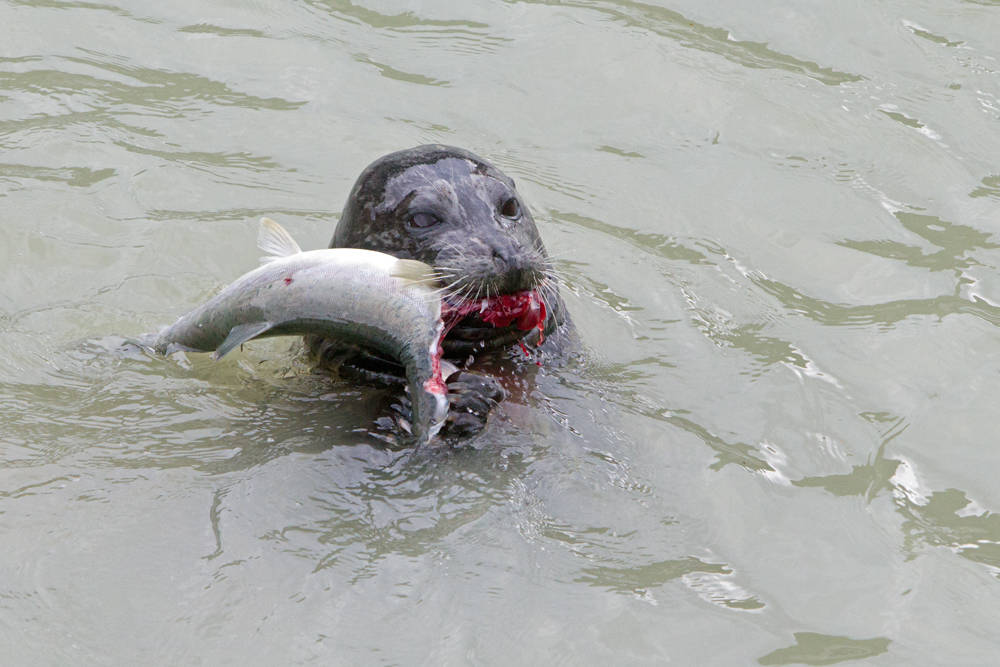Take a walk along the lower reaches of Eagle River, or a beach on west Douglas, or the Boy Scout beach, or any of a number of shore-side spots, and the chances are good that you’ll be observed by a floating bump of curiosity: a shiny dome with big dark eyes. Seals often follow the progress of beach walkers, swimming in parallel and keeping an eye on activity. Are they really just curious or are they on the lookout for suspicious, possibly dangerous, actions?
Seven (or possibly eight) species of true seals are recorded in Alaska, four of them mostly in the Bering Sea and the far north. Two more are occasionally seen: northern elephant seals, especially males, infrequently wander into the Gulf of Alaska from the south, and hooded seals (plus one other perhaps) sometimes drift into the north coastal area from the east. But here in Southeast, we have only the harbor seal on a regular basis. In the Pacific, this species ranges from the southern Bering Sea to California (and it also occurs in the north Atlantic). They are very closely related to the spotted seal, which ranges from the Beaufort Sea in the Arctic, through the Bering Sea, and down the coasts of Siberia and Japan. Spotted seals and harbor seals may even be one species, according to some researchers.
Harbor seals, foraging both in daylight and in the dark, prey on many kinds of fishes, as well as squid, octopuses, crabs, and shrimp. Very young, newly weaned pups concentrate on near-shore crabs and other crustaceans that can be caught quite easily. Adults commonly dive to a depth of up to fifty meters for five or ten minutes, but they are capable of plunging to at least five hundred meters and staying submerged for half an hour. Seals are exceptionally great divers (matched only by sperm whales). Their deep, protracted dives are possible because they have a very well-developed capacity to store oxygen (lots of red blood cells) needed for metabolism and a reduced metabolic rate while diving; and they often rest at the surface between dives.
Seals sometimes congregate at the mouths of rivers when the salmon are coming in to start the spawning runs (giving commercial fishermen heartburn). For several decades in the early 1900s, there was a bounty on them, for their presumed (not measured) competition with human fishers. In several rivers, seals even follow the salmon upstream for a distance; they sometimes appear in Mendenhall Lake. Up north, Lake Illiamna is home to a nearly unique fresh-water population of harbor seals (a few other freshwater populations exist in northeastern Canada). The Illiamna population, along with the salmon runs and other inhabitants of the area, is at risk from the proposed Pebble mine project.
Harbor seals mature at age three to six years, before they even reach full size. After an underwater courtship, mating typically occurs in summer. However, the fertilized embryo just floats around and does not implant in the uterus for two or three months. After that delay, gestation begins and lasts ten or eleven months; pups are born in spring. The single pup is nursed by the mother for three to six weeks. Toward the end of that time, it starts to follow her as she hunts, learning some basics of prey choice and capture. After the pup is weaned, the female is ready to mate again.
The very short length of time during which the pup is dependent on the mother’s milk is related to the richness of the milk. Marine mammals in general produce an energy-rich milk full of fats, and seal milk is at the top of this group, with about a fifty percent fat content. Protein content is correspondingly low, which means that the lean body mass of a pup at weaning is small—most of its growth in size is due to layers of fat that help sustain it as it learns to forage for itself. Pups can more than double their birth weight (about twenty-five pounds) during the time they feed on mother’s milk. The high energy content of the mother’s milk also indicates a high cost of milk production for the female, who forages seldom while nursing a pup and so pays much of the cost of lactation from her own fat stores.
Pup mortality is often very high, especially during their first year of life, when as many as fifty percent of them may die. This mortality rate no doubt varies from year to year and place to place, depending on the food supply and predation by killer whales, sharks, eagles, sea lions, and humans. Other sources of mortality for seals of all ages include entanglement in fishing gear and coastal pollution. Few harbor seals live longer than about thirty years.
• Mary F. Willson is a retired professor of ecology. “On The Trails” appears every Friday. Her essays can be found online at onthetrailsjuneau.wordpress.com.

